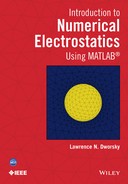Introduction
An introductory treatment of electrostatics usually begins with Coulomb's law, the concepts of charge, the electric field and energy stored in the field, potential, capacitance, and so on. Poisson's and Laplace's equations soon appear.
Unfortunately, almost no real world problem can be solved in closed form using the latter equations. The most basic of electrostatic device analysis, the electric fields surrounding and the capacitance of a simple parallel plate capacitor, cannot be found.
Typically, a few interesting solution techniques, such as the separation of variables, are presented. Then the author has to choose a path. Other solution techniques such as conformal mapping can be shown; if the book is to be more than an introductory text, more formal materials such as Greene's functions can be introduced. In any case, the practitioner with real world geometries to be analyzed has been abandoned.
A book about numerical analysis techniques typically presents just that – numerical analysis techniques. The few examples presented are usually based as much on the ease of their presentation as on their ultimate usefulness.
My goal in writing this book is to present enough basic electrostatic theory as necessary to get into real world problems, then to present several of the available numerical techniques that are applicable to these problems, and finally to present numerous, detailed, examples showing how these techniques are applied. In other words, I am presenting the basics of electrostatics and several relevant numerical analysis techniques, with the emphasis on practical geometries.
The numerical analysis of problems in fields such as electrostatics typically have three distinct phases:
- Pre-processing. The conversion of the physical description of the problem to a data set that is meaningfully digestible to the numerical analysis program chosen for the job.
- Numerical analysis. The calculations, based upon the data set describing the geometry and the chosen boundary conditions, resulting (typically) in an approximate solution for the voltage distribution over the chosen space.
- Post-processing. Calculations and programming necessary to provide summary data such as capacitance and computer visualization of the results.
This book will concentrate on item 2, the numerical analysis. Three fundamental techniques – method of moments, finite difference, and finite elements – are introduced. Sample problems are presented and computer code that solves the problems is developed.
In order to accomplish the above, some pre-processing capability is necessary. Rather than develop this capability or simply request that the reader “get it done,” several freely available packages are introduced and basic tutorials on their usage are presented. These tutorials are not exhaustive; they introduce enough of the capabilities of these packages to allow the student to follow, replicate, and extensively modify the examples to the student’s own needs. No claims are being made that the packages chosen are the best possible choices for the job. They are, however, choices that work well.
Post-processing of numerical analysis results, in this book, is done on an ad-hoc basis. Calculating the capacitance of a structure is often very useful because, if the example structure has been analyzed by other techniques and the results published, accuracy of results can be compared. This comparison allows for a convenient, one number figure of merit for choices of resolution, approximate boundary conditions, and so on. Often, graphical interpretations of field, voltage, and/or charge distributions are presented. These are useful as a quick visual check on the boundary conditions and on gaining insight into the electrostatic properties (high field points, etc.) of the structure being studied.
With only one exception, all the numerical analysis, post-processing and graphics were created using MATLAB®. This type of work is what MATLAB is designed to do. The analysis techniques presented convert partial differential equations into sets of linear equations with coefficients and variables represented by matrices and vectors. MATLAB is a scientific programming language designed with the matrix as the fundamental data type. The language is expressive, the available function list extensive and the easily used graphics superb.
MATLAB is fundamentally an interpreted computer language. It achieves impressive processing speeds by providing a liberal assortment of precompiled functions. Preparing user-written code for these functions involves a procedure that MATLAB calls “vectorizing.” Vectorizing means not writing explicit loops to process array elements because the language itself allows processing of all of the array elements simultaneously. From an authoring point of view, this raises a question: Should demonstration code be vectorized as much as possible in the name of program execution speed or should demonstration code be written to explicitly parallel the derivations of the formulas in the text in the name of pedagogical clarity?
There is no absolutely right answer to the above question. In every case in this book judgment calls were made – vectorized code is shown when the algorithm seems “clear enough.” This compromise, like all compromises, won’t please everybody every time; ideally, it will please enough readers enough of the time.
The problems at the end of the chapters were written, as much as possible, to be extensions of the chapters, rather than “verify XXX or put numbers into YYYY.” Many of the problems involve modifying existing or writing new MATLAB code, leading to capabilities that were not presented in the chapters’ materials. When the thrust of the problem isn’t to extend the modeling capability, it is to make a point about the electrostatics issues involved in the example being treated. In all cases, solving the problems and reading the solution discussions will be an integral part of the learning process.
Solutions to end-of-chapter exercises may be found at the book companion site, www.wiley.com/go/numerelectrostatics. Additional resources may be found at www.lawrencedworsky.com.
